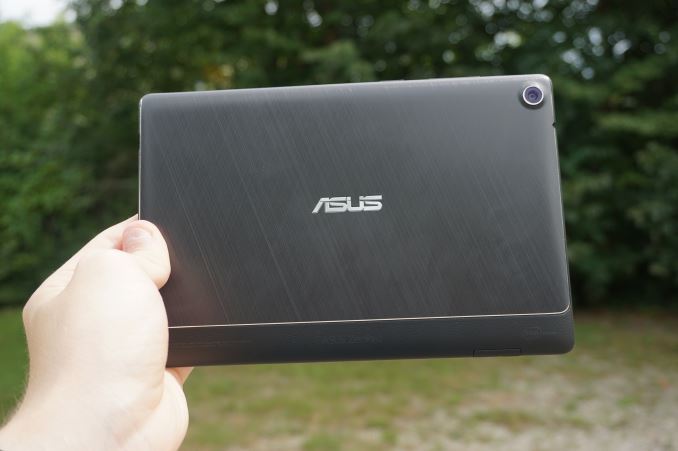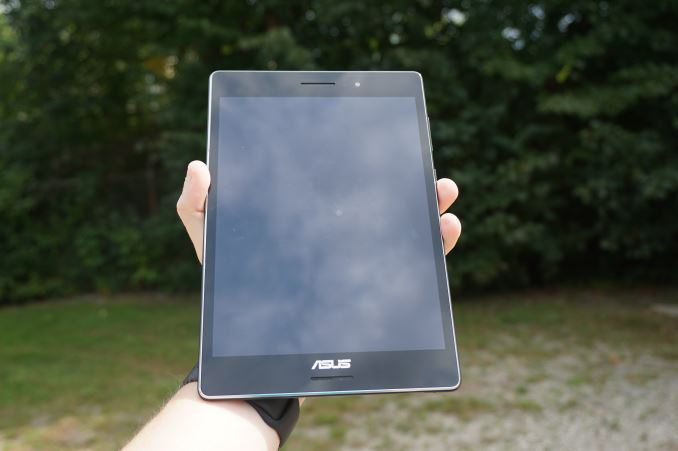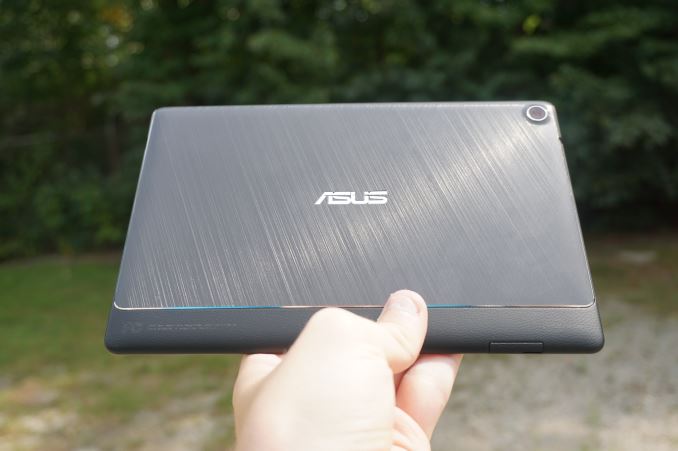The ASUS ZenPad S (Z580CA) Review
by Brandon Chester on August 31, 2015 8:00 AM ESTFinal Words
As I said in the introduction, its been a long time since we've seen a tablet from ASUS that wasn't aimed at the low end of the market. The ZenPad S Z580CA isn't a $500 flagship tablet, but with the specifications it provides it's essentially a high end 8" Android tablet. Like the ZenFone 2, its $299 price would have you believe that its specifications are less impressive than they really are. However, it's really impossible to judge a device solely based on how it looks on paper, even when what you seen on a spec sheet looks appealing. Over the course of reviewing the ZenPad S I've encountered aspects of it that are good, and some that need improvement. I suppose this is the best time to go over everything once more before making some conclusions.
The ZenPad S does a good job of making a plastic chassis feel solid and high quality. The hard plastic on the back does a better job of emulating the feeling of metal than any other device I've used before. I personally would have not opted to make the sides and part of the back cover out of a soft touch plastic, because it introduces seams and breaks in the chassis which is detrimental to the design. I also feel a bit spoiled by the fact that there are devices like the iPad Mini 2 which give you a fully aluminum chassis for $299 as well. The ZenPad ends up being thinner and much lighter than the iPad, which is certainly a benefit for any user who wants a device that they can bring everywhere without feeling like they're lugging around a heavy object. My personal use case for a tablet leads me to lean toward a thicker and heavier aluminum chassis over a thinner and lighter plastic one, but I recognize that other people may have different needs which make the ZenPad S a more appealing device in that regard.
One area where an aluminum chassis would certainly help is durability. While metal can obviously dent and scratch, my time with the ZenPad S has made it clear that there are both issues with the durability of the plastic used, and with the tolerances for defects in the materials. If I was purchasing the ZenPad S for myself I would definitely not consider the deformed edges of the hard plastic that my review unit has to be acceptable, and the same would go for the easily damaged edge around the bezel. Even without a metal chassis, other plastic tablets like the Dell Venue 10 and the Nexus 9 have held up much better over the course of weeks and months than the ZenPad S did in only a week. Durability is definitely something to keep in mind if you're fairly rough on your devices, or if you want to keep your ZenPad for a long period of time.
As far as performance goes, the ZenPad S is right in line with all the other Intel devices that I've looked at. The 4GB of RAM means that you will rarely ever see a process be evicted from memory, but with Android having no support for split screen application views it almost feels like the ZenPad S has some untapped potential. The CPU performance is just as good if not better than anything else you'll find at this price, and the 533MHz G6430 GPU ends up being slightly faster than the implementation in Apple's A7 SoC. In my reviews of Dell's Venue tablets I remarked that Atom Z3580 didn't feel competitive enough in a $400 or $500 device, but in a $300 tablet it feels right at home.
The ZenPad's display is difficult to come to a conclusion on. Out of the box the image rendition is very inaccurate, but you can make significant improvements by adjusting the color temperature. My problem with this is that I think it's wrong to offer bad default settings that the user has to fix on their own, especially when there's no way they can find the optimal setting for a display by using their eye alone. Even after adjusting the display, the overall accuracy is still significantly lower than the iPad Mini 2 despite the ZenPad S not suffering from the narrow gamut that the iPad does.
On top of the issues with color accuracy, ASUS's True2Life+ tweaks have a very negative impact on display quality. The over-sharpening causes halos around text, and when text is a small size it actually makes it more difficult to read than it would be if it hadn't been artificially sharpened, which is contrary to the entire point of sharpening. ASUS's CABC also goes way overboard, to the point where you can notice the brightness of the display constantly shifting as you scroll around and move between apps. Without True2Life+ I would still lean toward the iPad Mini 2 having a better display due to its greater accuracy with common color mixtures, even if it does have a narrow gamut and isn't laminated. Despite that, I would have said that the ZenPad S's display is still very good for a $299 device. Unfortunately, the post processing that ASUS performs really degrades image quality to the point where the ZenPad's display is not something I can highly praise.
There's not much to say about the camera quality of the ZenPad S. It suffers from all the same issues as the ZenFone 2, and I really wouldn't use it to take photos unless there's no alternative. Thankfully I don't think that the camera is a huge selling point for a $300 tablet, and so this problem isn't that serious.
Battery life on the ZenPad S was good considering the battery capacity it's working with, but not competitive with other tablets. With tablets there's really no room to have your battery life fall short, because there's been an expectation of ten hours of battery life from tablets for over five years now. In every battery category the ZenPad either doesn't last as long as competing tablets, or lasts as long or longer but with the caveat that performance over that period of time wasn't as high as the competition. I think a larger battery would have really been beneficial, even if it meant that the ZenPad S Z580CA had to be heavier and 7mm or 7.5mm thick instead of 6.6mm.
In the end I'm not as impressed by the ZenPad S Z580CA as I was with the ZenFone 2. In the case of the ZenFone 2 I actually felt that the $199 model offered the best value because you were only trading away some NAND, dropping to 2GB of RAM, and limiting the CPU clock to 1.8GHz instead of 2.33GHz. If the ZenPad S Z580C was the same sort of downgrade I would have no trouble recommending it for $199. However, you end up with significant reductions to both the CPU and GPU clocks, worse cameras, halved RAM and NAND, no 802.11ac WiFi (assuming it gets fixed on the Z580CA), and no USB Type-C connector. That's a lot of sacrifices to save $100, and the performance impact of dropping the max CPU clock to 1.33GHz would be very significant in bursty workloads.
As for the Z580CA itself, there are just a lot of issues that are difficult to overlook. The build quality and construction is just not competitive with the iPad Mini 2 or the more expensive but still relevant Dell Venue 8 7840. Much of the other issues are rooted in software, like the WiFi issue, the display issues, the camera issues, and before a recent software update, the video playback issues. While I didn't talk about ZenUI in this review, anyone who visited the link to my discussion of it in my ZenFone 2 review knows that you'll also be dealing with a large number of pre-installed apps on the ZenPad S, with most of them not being very useful. There's also still the fact that the library of really good tablet apps for Android devices is still quite small, and while this isn't within ASUS's control, it's still a very real issue to consider when you have the iPad Mini 2 competing at the exact same price.
At $299, the ZenPad S Z580CA actually doesn't have much in the way of direct competition from other Android OEMs. The $399 price point seems to be where a lot of manufacturers have aimed, with devices like the Dell Venue 8, Nexus 9, and Galaxy Tab S2 8.0 all selling for that price. With that in mind, the ZenPad S does end up being the best device at its price point, but due to a lack of competition more than anything else. If I were recommending a tablet to someone aiming to spend around $299 I would still lean toward the iPad Mini 2 if they weren't partial to Android or iOS. If someone does really need a tablet that runs Android for any number of reasons then I think it would be best to save up and take a look at the devices selling for around $400. That being said, if a user can't use a tablet that runs iOS and can't budge from a $300 price, then the ZenPad S Z580CA appears to be the best of the few options available.













114 Comments
View All Comments
uhuznaa - Monday, August 31, 2015 - link
Things are strange right now: You can get an 8" (retina) iPad Mini 2 for $299 and at the same time Android tablets are either a little bit cheaper and really crappy or more expensive and not really much better.If even Apple is struggling now to sell iPads I somewhat doubt that such Android tablets are selling great now...
retrospooty - Monday, August 31, 2015 - link
I dont know about that. I got the $199 Asus Zenpad S 8 a month ago and am loving it. Like all Androids from OEM's, you really need to spend a bit of time to root it and debloat it to make it shine. Debloated this thing flies. For $199 you get an 8 inch 2048x1536 screen, 32gb storage + SD, great build quality, thin, light, great battery life, fingerprint resistant on all surfaces and the CPU is great as well. I was worried about using an Atom chip, but in actual use, it runs perfectly smooth and cool as well. In fact cooler than any Snapdragon device I have ever used. It doesnt get hot at all, ever and I live in Arizona and it's summer. EASILY the best "bang for your buck" available in a tablet right now from any vendor.MrSavage - Monday, August 31, 2015 - link
@retrospooty, I agree with you. People who review a product at a certain price point who want to compare that to products that are about 1/3 more expensive? Or they simply omit the good features like the 64GB onboard storage in this situation, or the front facing speakers, the stylus support or the microSD slot? As if the $299, 2-year old iPad mini 2 with 16GB storage is a wiser choice. If the reviewer wants big battery life, best this, and best that? Then add another $100 to the price of the Tab S2 8.0 for all the features it's lacking that the Z580CA has.BurntMyBacon - Wednesday, September 2, 2015 - link
I agree and disagree. You are welcome to compare it to a product that is 1/3 more expensive, so long as you make it known that that product is 1/3 more expensive. If you stress the comparison against a disparate competitor, then you need to stress the price differential as well. I agree it is disingenuous to point out things that may bring value on one side (display quality, build, aspect ratio, etc.) while ignoring the value adds on the other (SD slot, Storage, Stylus, etc,).Note: My comparison is between two imaginary products and has no bearing on products explicitly or implicitly called out in this article or thread. Comparison was made only to illustrate the point that talking about value distinctions without all of the data is impossible. You may not value the items you left out, but the party you are talking to might.
BurntMyBacon - Wednesday, September 2, 2015 - link
@retrospooty: Given what I've read about the new Atoms, I would probably consider it a boon to a tablet rather than a point of worry. A lot of people seem to be on an ARM or nothing kick. While I was pretty enthusiastic about ARM processors (still am) and I love the competition and what it has done for Intel's low end, I now find there is a lot to like about the Atoms in this form factor as well. Atom got a bad name from its netbook days when it was, frankly atrocious for the application. Now it has matured significantly from a performance / watt standpoint and is running an OS that doesn't run like dirt on low end processors. Of course another nicety of the Atom is its ability to support alternate x86 operating systems if you really want to, but then you have to question whether it is capable of giving you the experience you want. ARM will probably move ahead with its A72 in the near future, but that's a good thing. A little back and forth is good for keeping things moving.BugblatterIII - Monday, August 31, 2015 - link
Do not trust Asus to fix issues!I had (and still have) a Transformer Prime. They never managed to get that working acceptably.
Base your buying decision on how it is at launch, and if they do manage to fix the issues then count that as a bonus.
MrSavage - Monday, August 31, 2015 - link
Did you not get the dongle they created? The Prime was a design flaw. They couldn't software fix their way out of it. If you didn't or don't have the dongle, then I suppose blame yourself.invinciblegod - Monday, August 31, 2015 - link
oh REALLY, an external GPS dongle to do what it should have done in the first place? No, no one should blame themselves, they should blame asus for making a bad product.MrSavage - Monday, August 31, 2015 - link
A design flaw is a design flaw. You can hold onto that issue for the rest of your life if you so choose. You want to miss out of price friendly Asus products because of a design flaw on a second even generation, ground breaking device, then be my guest. I bet you didn't even know about the dongle. The fact is the issue was resolved, albeit a lousy solution. Again, you hold that against them for the rest of your life. That's your odd choice, and if you're okay with it, then so am I.3DoubleD - Monday, August 31, 2015 - link
The dongle fiasco was far from the worst of it though - missing GPS on a 10" tablet was really not a big deal. The Transformer Prime was a complete failure in the end due to the TERRIBLE eMMC that was used. Storage performance just plummeted after a time and while the occasional TRIM helped a bit, it was (and still is) painful to use. Once you are in an app... not so bad. Navigating Android was like watching grass grow... very choppy, laggy grass.It was very sad what happened to the Prime... I remember when I first got it, it blew away any Android device I'd ever used. It is one of two electronic device or computer component purchases I've completely regretted buying. (The other was an AGP Radeon x850XT... that was just outright stupidity on my part)
So that experience colors my view of all ASUS products now. They make some nice looking devices that sometimes have great value... but I just can't help think that they are not fully tested. (As for their PC components, I've had nothing but good experiences)